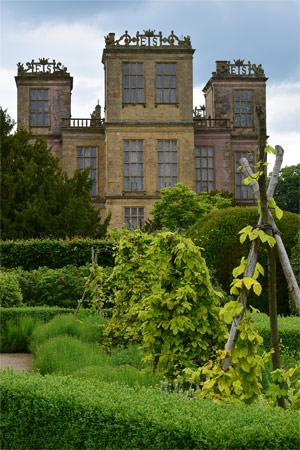Hardwick Hall exudes the ego of Bess of Hardwick - its builder - as much as it is today buffeted by the constant drone of traffic from the nearby M1 motorway, both equally transient and fleeting yet strangely permanent. You can block out the noise pollution that arises from below but the ego from the past pulses through the place with unstoppable energy.
Hardwick Hall is one of the National Trust’s flagship properties. As an Elizabethan masterpiece it is important nationally and thus deserves a significant upkeep budget to keep attracting visitors (well over a quarter of a million of us in 2018). Its famous soubriquet of “Hardwick Hall, more glass than wall” attested to Bess’s wealth at a time when glass was more expensive than stone or brick. With such fragile and thin glazing the requirement for tapestry to keep out the drafts resulted in Hardwick also having an extraordinary collection of Elizabethan tapestries. Externally, the Countess of Shrewsbury’s initials and coronet adorn the parapets fourteen times. There is no modesty in this abode of the Queen of the North. It’s been a flagship since the day it was built, a prodigy house intended to welcome the true Queen, Elizabeth, who never did visit.
The procession upwards to the Elizabethan Long Gallery
Hardwick was designed to provide a theatrical experience, particularly for those who visited its wealthy owner. The entrance hall spanned the depth of the building, front to back, and was filled with light and bright furnishings, an unusual and distinctive configuration. The owner would be waiting at the top of the building, on the second floor, so a procession up three flights of stairs was necessary, the final one being a curved, stone staircase. Up on this second floor are Hardwick’s two principal spaces, the High Great Chamber and the Long Gallery. No visitor to Hardwick will easily forget either.
Ascending with anticipation towards the state rooms, one is reminded of the curved stone steps at Wells Cathedral
Hardwick Hall’s extraordinary Long Gallery, here part-hung with an exhibition of photographs of contemporary women - Rachel Adams’ We are Bess exhibition
Hardwick’s Long Gallery is not the longest in the country. Montacute (this website) pips it at the post. However, it is the largest, due to its height and width.
Our visit coincided with the We Are Bess exhibition arranged in conjunction with the National Trust. Hardwick’s Long Gallery is the archetypal space for hanging historic portraits. Bess of Hardwick used the space for portraits of her own family and for important and influential people of the day. Twenty new, large photographic portraits of contemporary women were hung alongside these for the exhibition. Many of these women were household names, familiar to us from the TV, such as the historian Professor Dame Mary Beard and the news presenter Cathy Newman. Others were less well-known, private individuals. Their portraits attempted to draw out the similarities between themselves and Bess, Elizabeth Talbot, Countess of Shrewsbury.
The High Great Chamber and its plaster friezes
Extraordinary though Hardwick’s Long Gallery undoubtedly is, it is the High Great Chamber that leaves the stronger mark. This is where the countess would have greeted her guests and served them dinner. A massive alabaster and marble chimney-piece and Brussels tapestries telling the story of Ulysses and his wife Penelope decorate the lower walls. Above them ranges an extraordinary plaster frieze depicting Diana the huntress flanked by a sinewy forest of trees through which deer, lions and wild boar are chased down and slaughtered by hunters and their hounds, all in three-dimensional relief. The original foliage green and red of blood and robe stand out against a background of ghostly grey. On one wall, elephants and camels attend the hunter-goddess’s commands. On another, a unicorn witnesses a hunter plunging a halberd (or boar spear) into the rump of a wild boar. Here is Diana, virgin goddess of the hunt, in her sacred grove, co-opted by Bess of Hardwick as amplifier of her own feminine power. If anything, the comparison served to amplify the magnitude of Bess of Hardwick’s ego. (The photograph below - captioned with asterisks - is a panorama stitched from three separate photographs. This was tricky to accomplish so the detail captured might not be widely available. Worth a click for the large version.)
I remain largely dispassionate about Hardwick. Even its Elizabethan heritage fails to help its bling-factor get through my defences. This post is unashamedly intended as a vehicle for pixels so much more than words.





















